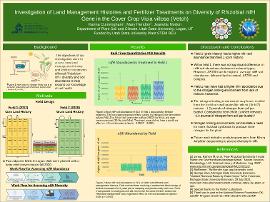| dc.contributor.advisor | Norton, Jeanette | |
| dc.contributor.author | Cunningham, Karina | |
| dc.contributor.author | Hendon, Mary | |
| dc.contributor.other | Utah State University | |
| dc.date.accessioned | 2021-09-28T01:09:21Z | |
| dc.date.available | 2021-09-28T01:09:21Z | |
| dc.date.issued | 2021-10-09 | |
| dc.identifier | oksd_OK-LSAMP_2021_cunningham | |
| dc.identifier.citation | Cunningham, K., Hendon, M., & Norton, J. (2021, October 9). Investigation of land management histories and fertilizer treatments on diversity of rhizobial nifH gene in the cover crop Vicia villosa (Vetch). Poster session presented at the Oklahoma Louis Stokes Alliance for Minority Participation's 27th Annual Research Symposium, Stillwater, OK. | |
| dc.identifier.uri | https://hdl.handle.net/11244/330973 | |
| dc.description.abstract | The Vicia villosa (Vetch) cover crop fixes nitrogen through symbiotic processes with soil bacteria Rhizobium leguminosarum biovar viciae. This bacterium has a marker gene, nifH, that is part of the nitrogen-fixing enzyme. The objectives of our investigation were to assess how land management history and fertilizer treatment affected nifH gene diversity and nifH soil abundance. The goal of this study was to improve our understanding of the interaction between nitrogen fertilizer application and nitrogen-fixing bacteria. Root nodules and bulk soil samples from two fields with different land management histories were examined. Field one had a land management history of corn and was planted with a vetch cover crop organized in a randomized block design of 16 plots with four fertilizer treatments: control (no-nitrogen), low-ammonium sulfate (AS112 kg N/ha), high-ammonium sulfate (AS224 kg N/ha), and steer-manure compost (224 kg total N/ha). Field two had a land management history of small grains and was planted with a vetch cover crop organized in a block design of 16 plots without fertilizer treatments. We hypothesized that nifH diversity and nifH soil abundance would vary depending on fertilizer nitrogen composition and land history. Real-time quantitative PCR was run on DNA isolated from bulk soil samples of the 32 plots to quantify nifH soil abundance. The real-time PCR showed no significant difference between fertilizer treatments in field one, but field two (small grain history) had a significantly higher abundance than field one (corn history). This result may have occurred due to the nitrogen limiting environment in the unfertilized plots in field two. This may have led to a higher affinity for rhizobium symbiosis to create nitrogen for the plant. Future work includes analysis of Miseq Amplicon sequences from root nodule DNA to assess nifH diversity. | |
| dc.description.sponsorship | Oklahoma Louis Stokes Alliance for Minority Participation Program | |
| dc.description.sponsorship | National Science Foundation (U.S.) | |
| dc.description.sponsorship | Utah State University. Plant STEM Research Experience for Undergraduates Program | |
| dc.format | application/pdf | |
| dc.language | en_US | |
| dc.publisher | Oklahoma State University | |
| dc.rights | In the Oklahoma State University Library's institutional repository this paper is made available through the open access principles and the terms of agreement/consent between the author(s) and the publisher. The permission policy on the use, reproduction or distribution of the article falls under fair use for educational, scholarship, and research purposes. Contact Digital Resources and Discovery Services at lib-dls@okstate.edu or 405-744-9161 for further information. | |
| dc.title | Investigation of land management histories and fertilizer treatments on diversity of rhizobial nifH gene in the cover crop Vicia villosa (Vetch) | |
| osu.filename | oksd_OK-LSAMP_2021_cunningham.pdf | |
| dc.description.department | Plant Soil and Climate | |
| dc.type.genre | Poster | |
| dc.type.material | Text | |
| dc.subject.keywords | plant biology | |
| dc.subject.keywords | soil science | |
| dc.subject.keywords | microbiology | |
| dc.subject.keywords | agriculture | |
| dc.subject.keywords | cover crops | |
